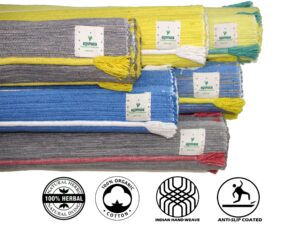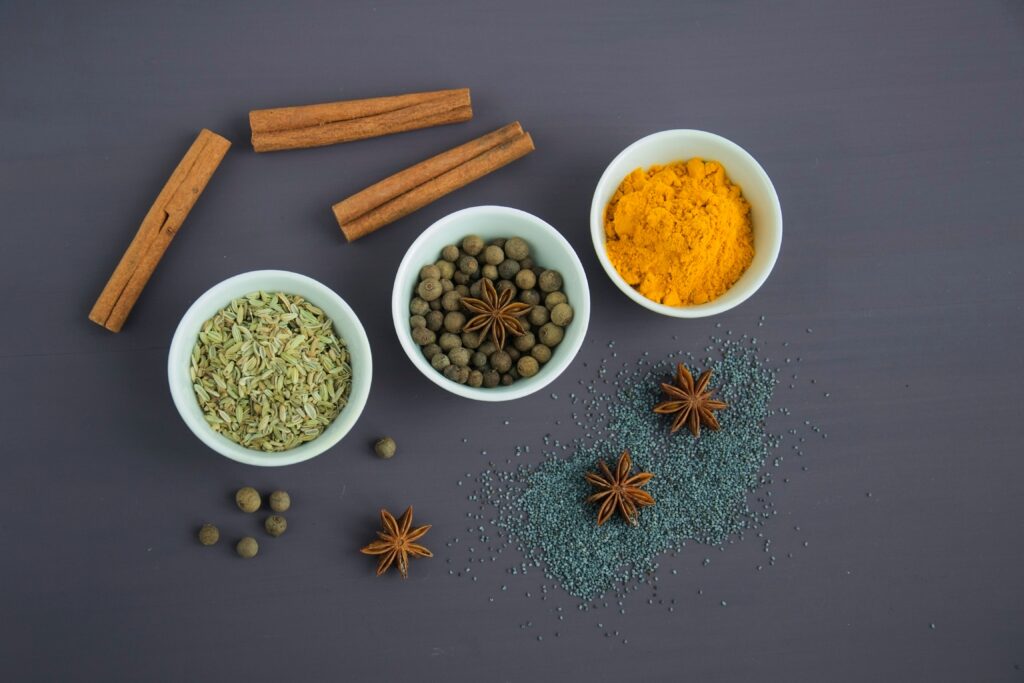Plants and herbs are usually much healthier than most synthetic dyes out there. Synthetic dyes often have nasty chemicals that have links to cancer, birth defects, and more; using all-natural dye is a safer alternative. Not only does using plants give you a more natural looking color, but it also helps your skin in terms of wellness; some plants are well known to help with eczema and other skin problems. It’s sustainable: Natural dying not only uses less water than commercial dying methods, but it also keeps those harmful microfibers from entering our water supply. It’s organic: All-natural dyes don’t contain any synthetics or harsh chemicals like many commercial brands do. And, since they’re made from plants, they are completely organic—and safe for even sensitive skin types! It has benefits for your health: Many plants used as dye can actually be good for you!

Explore our range of Ayurvedic-infused yoga mats designed to enhance your holistic well-being. Check them out here
Turmeric
A primary ingredient in curry, turmeric is also a powerful skin-toner. Turmeric can be used as a powder or spice, and when applied to skin it acts as a gentle antibacterial and fades freckles or age spots. This makes it a natural choice for sustainable dyeing that doesn’t damage your health or skin long term (like traditional clothing dyes). Native cultures traditionally grind turmeric into yellowish powder, which they use to create bright yellow cloth.
Aloe Vera
An herbaceous plant, aloe Vera offers countless medicinal benefits. For instance, it contains polysaccharides and enzymes that can help to heal skin injuries. The sap from its leaves can also reduce inflammation when applied to a wound. Aloe vera also provides a slew of other benefits, including stress relief and antioxidant properties. Though it is most commonly used topically, aloe veras effects can also be felt internally.
Hibiscus Flower
Also known as Malihini, Hibiscus flower has numerous health benefits including calming skin conditions like eczema and psoriasis, reducing inflammation and relieving minor skin wounds. It also has anti-bacterial properties that can reduce your risk of respiratory illnesses like sore throats and colds. The juice of hibiscus flowers can be used to relieve gastrointestinal issues such as diarrhea or constipation. They have even been shown to be effective in lowering blood pressure levels when taken regularly.
Natural Indigo
Used as a dye for clothes in many countries including India, natural indigo is a great addition to your herbal medicine cabinet. With antibacterial and antifungal properties, indigo can be used to treat skin infections like acne and eczema.
Neem
In India, neem is used as both a medicinal plant and dye. The wood of neem has anti-fungal properties, making it especially useful in preventing yeast infections like jock itch. And, yes—that’s from personal experience! If you have chapped lips or skin blemishes, try using a paste made from neem on these areas. Simply crush some leaves and apply topically for best results. The biggest benefit to growing your own herbs and dying them with natural dyes is knowing exactly what went into creating your clothing.
Red Sandalwood
If you’re looking to create a healthy, organic wardrobe without resorting to chemicals, look no further than red sandalwood. Not only does it have skin-healing properties and medicinal benefits, but it’s also been said to promote hair growth, fight wrinkles and alleviate depression. Talk about your all-in-one!
Let us know your choice of herb and we will make the herbs infused clothing range for you.
Namasthe!
MOHA IMPEX

